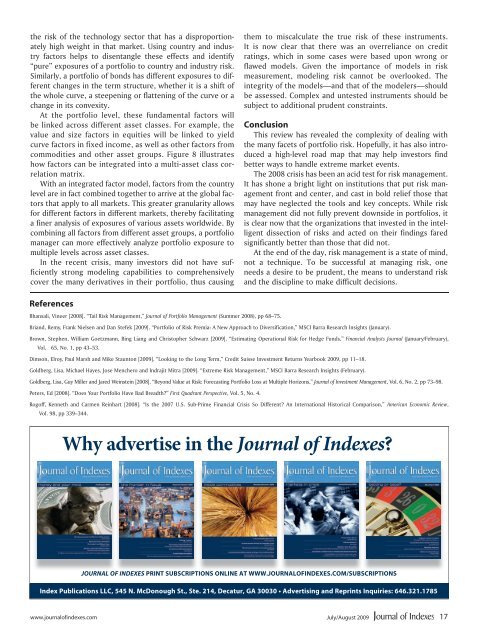How to Kill a Black Swan Remy Briand and David Owyong ...
How to Kill a Black Swan Remy Briand and David Owyong ...
How to Kill a Black Swan Remy Briand and David Owyong ...
You also want an ePaper? Increase the reach of your titles
YUMPU automatically turns print PDFs into web optimized ePapers that Google loves.
the risk of the technology sec<strong>to</strong>r that has a disproportionately<br />
high weight in that market. Using country <strong>and</strong> industry<br />
fac<strong>to</strong>rs helps <strong>to</strong> disentangle these effects <strong>and</strong> identify<br />
“pure” exposures of a portfolio <strong>to</strong> country <strong>and</strong> industry risk.<br />
Similarly, a portfolio of bonds has different exposures <strong>to</strong> different<br />
changes in the term structure, whether it is a shift of<br />
the whole curve, a steepening or flattening of the curve or a<br />
change in its convexity.<br />
At the portfolio level, these fundamental fac<strong>to</strong>rs will<br />
be linked across different asset classes. For example, the<br />
value <strong>and</strong> size fac<strong>to</strong>rs in equities will be linked <strong>to</strong> yield<br />
curve fac<strong>to</strong>rs in fixed income, as well as other fac<strong>to</strong>rs from<br />
commodities <strong>and</strong> other asset groups. Figure 8 illustrates<br />
how fac<strong>to</strong>rs can be integrated in<strong>to</strong> a multi-asset class correlation<br />
matrix.<br />
With an integrated fac<strong>to</strong>r model, fac<strong>to</strong>rs from the country<br />
level are in fact combined <strong>to</strong>gether <strong>to</strong> arrive at the global fac<strong>to</strong>rs<br />
that apply <strong>to</strong> all markets. This greater granularity allows<br />
for different fac<strong>to</strong>rs in different markets, thereby facilitating<br />
a finer analysis of exposures of various assets worldwide. By<br />
combining all fac<strong>to</strong>rs from different asset groups, a portfolio<br />
manager can more effectively analyze portfolio exposure <strong>to</strong><br />
multiple levels across asset classes.<br />
In the recent crisis, many inves<strong>to</strong>rs did not have sufficiently<br />
strong modeling capabilities <strong>to</strong> comprehensively<br />
cover the many derivatives in their portfolio, thus causing<br />
them <strong>to</strong> miscalculate the true risk of these instruments.<br />
It is now clear that there was an overreliance on credit<br />
ratings, which in some cases were based upon wrong or<br />
flawed models. Given the importance of models in risk<br />
measurement, modeling risk cannot be overlooked. The<br />
integrity of the models—<strong>and</strong> that of the modelers—should<br />
be assessed. Complex <strong>and</strong> untested instruments should be<br />
subject <strong>to</strong> additional prudent constraints.<br />
Conclusion<br />
This review has revealed the complexity of dealing with<br />
the many facets of portfolio risk. Hopefully, it has also introduced<br />
a high-level road map that may help inves<strong>to</strong>rs find<br />
better ways <strong>to</strong> h<strong>and</strong>le extreme market events.<br />
The 2008 crisis has been an acid test for risk management.<br />
It has shone a bright light on institutions that put risk management<br />
front <strong>and</strong> center, <strong>and</strong> cast in bold relief those that<br />
may have neglected the <strong>to</strong>ols <strong>and</strong> key concepts. While risk<br />
management did not fully prevent downside in portfolios, it<br />
is clear now that the organizations that invested in the intelligent<br />
dissection of risks <strong>and</strong> acted on their findings fared<br />
significantly better than those that did not.<br />
At the end of the day, risk management is a state of mind,<br />
not a technique. To be successful at managing risk, one<br />
needs a desire <strong>to</strong> be prudent, the means <strong>to</strong> underst<strong>and</strong> risk<br />
<strong>and</strong> the discipline <strong>to</strong> make difficult decisions.<br />
References<br />
Bhansali, Vineer [2008]. “Tail Risk Management,” Journal of Portfolio Management (Summer 2008), pp 68–75.<br />
<strong>Bri<strong>and</strong></strong>, <strong>Remy</strong>, Frank Nielsen <strong>and</strong> Dan Stefek [2009]. “Portfolio of Risk Premia: A New Approach <strong>to</strong> Diversification,” MSCI Barra Research Insights (January).<br />
Brown, Stephen, William Goetzmann, Bing Liang <strong>and</strong> Chris<strong>to</strong>pher Schwarz [2009]. “Estimating Operational Risk for Hedge Funds,” Financial Analysts Journal (January/February),<br />
Vol. 65, No. 1, pp 43–53.<br />
Dimson, Elroy, Paul Marsh <strong>and</strong> Mike Staun<strong>to</strong>n [2009]. “Looking <strong>to</strong> the Long Term,” Credit Suisse Investment Returns Yearbook 2009, pp 11–18.<br />
Goldberg, Lisa, Michael Hayes, Jose Menchero <strong>and</strong> Indrajit Mitra [2009]. “Extreme Risk Management,” MSCI Barra Research Insights (February).<br />
Goldberg, Lisa, Guy Miller <strong>and</strong> Jared Weinstein [2008]. “Beyond Value at Risk: Forecasting Portfolio Loss at Multiple Horizons,” Journal of Investment Management, Vol. 6, No. 2, pp 73–98.<br />
Peters, Ed [2008]. “Does Your Portfolio Have Bad Breadth?” First Quadrant Perspective, Vol. 5, No. 4.<br />
Rogoff, Kenneth <strong>and</strong> Carmen Reinhart [2008]. “Is the 2007 U.S. Sub-Prime Financial Crisis So Different? An International His<strong>to</strong>rical Comparison,” American Economic Review,<br />
Vol. 98, pp 339–344.<br />
Why advertise in the Journal of Indexes?<br />
journal of indexes PRINT SUBSCRIPTIONS ONLINE AT WWW.jOURNALOFINDExES.COM/SUBSCRIPTIONS<br />
Index Publications LLC, 545 N. McDonough St., Ste. 214, Decatur, GA 30030 • Advertising <strong>and</strong> Reprints Inquiries: 646.321.1785<br />
www.journalofindexes.com July/August 2009<br />
17
















